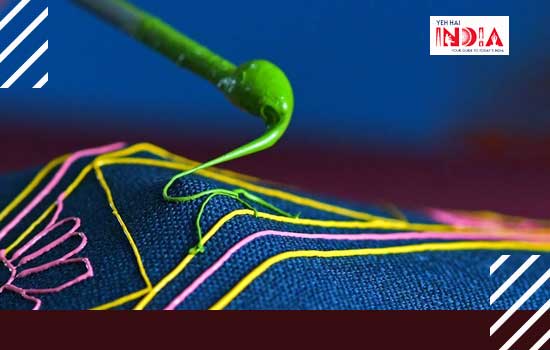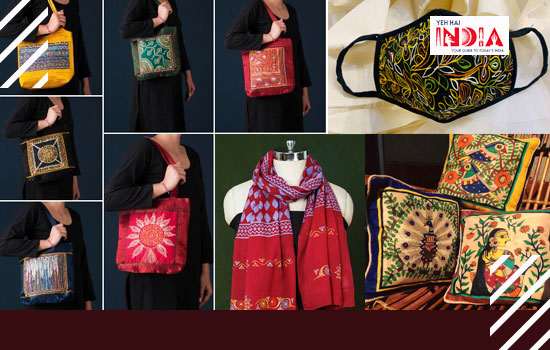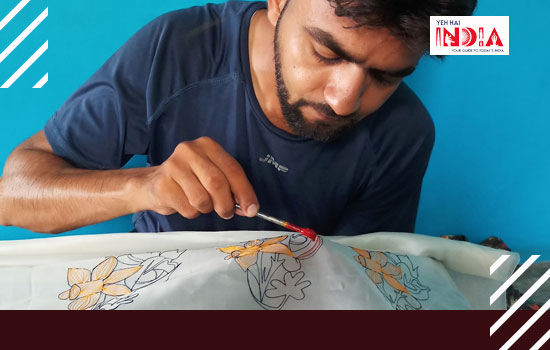India has been blessed with several art forms that reflect its traditions, culture, heritage, and life styles.
Each craft has its unique identity and displays the stories of bygone eras, ancestors, kingdoms, livelihoods, and statehoods.
One of many such art forms is the ‘Rogan Art’.
It has become a prominent part of our heritage though the form travelled to India from West Asia.
The art has a unique distinction of having hundred years of history but is now practiced by a lone family in Nirona of Kutch, Gujarat, India.
Let us know the story of this craft and its craftsmen!
Meaning of Rogan Art

The word ‘Rogan’ means oil in Persian.
The art form involves painting on fabrics by thick, brightly colored paste made from castor oil seeds.
Castor seeds are hand-pounded to extract oil and turned into thick paste.
The paste is made by boiling castor oil for nearly 2 days.
The boiling involves a tiresome work of continuously stirring for more than 12 hours.
This residue is then mixed with cold water until it thickens to sticky and elastic paste, called ‘rogan’.
Recommended Story – Top Startups Promoting Fabric Crafts of India
Usage of Rogan Art

Rogan painting is culturally a seasonal artform.
The painting is utilized to ornament traditional attires and fabrics like Lehanga, Ghagra, Chabla, Dupatta, and Odhani.
Household fabrics such as bedsheets, pillow covers, quilts, and cover dishes are also painted through Rogan.
Rogan painted fabrics are essential components for various Guajarati rituals.
These fabrics are often used as dowry fabrics in weddings and offerings in pujas and festivals.
Origin and History of Rogan Art

Rogan is yet another example of collaborative union of histories in the Indian sub-continent.
The craft dates back to nearly 400 hundred years and is believed to have arrived India through the Afridis, who are mainly from Syria.
The Afridis travelled in the North-Western regions of Afghanistan, Pakistan, Persia, and Central Asia.
Many of the crafts were found to be concentrated in these regions even in the mid 20th century.
The art was mainly practiced by Muslim decedents of Afridis.
The paintings are also given the names, Peshawari Lac Cloth and Afridi Lac Cloth.
The art did not find much recognition until it arrived the north-western fronts of India.
Castor oil, the primary component of the raw material, is richly produced in the Kutch regions of Gujarat.
Though the extraction was found to be tedious, the process slowly spread to other areas and led to the settlement of nomadic tribes.
The craft was later prioritized by many villages, especially the Ahris of Kutch.
Design of Rogan Art

The motifs and patterns used in Rogan are both traditional and contemporary.
Generally, geometrical motifs are preferred to design symmetrical layouts and arrangements.
Repeated curvilinear patterns are the most common features of rogan paintings.
The symmetry is created through double impression and folding, peeling of the cloth, which leaves a mirror image.
Phools(flowers), Jhad(Trees), Trikhani(Three Dots) are the oldest found motifs.
Contemporary motifs include circular and concentric patterns, architectural elements like jails, screens etc.
‘The Tree of Life’ is the most famous pattern found in the rogan paintings.
The Wall hangings done in Rogan style also feature daily lives of villagers, trees, cattle, animals, and birds.
Recommended Story – Kalamkari: A Unique Artform
Rogan Art – Production and Tools

In India, the craft is believed to stem from traditional Gujarati agriculture.
This is the major occupation in the villages that produced rogan.
Castor seeds are the major cultivation in the Kutch and draw a natural connection to the craft.
The raw materials are available easily and pose no hassle.
The paste is made manually out of castor seeds in yellow, red, blue, black, and green.
These are stored in earthen pots with water to prevent from drying.
The Kalam, or the iron rod, flat at both the ends, is used to paint half of the design with the support of left-hand fingers.
It is then impressed on the other half, which creates a symmetric motif on the fabric.
The rod is said to ‘pre-manipulate’ the strand of color in the air to create any intended motifs.
The fingers help shape the final form of fabric. In this way, rogan creates a dialogue between two hands.
A Turn in the 80’s

The art was kept alive for generations until its downfall in the 1970s and 80’s.
Lack of opportunities took the art to the brink of extinction.
Many villages of Gujarat that once practiced Rogan, switched to other trades and businesses.
Nevertheless, it was the story of young Abdul Gafur Khatri, which redefined the story of this rich heritage.
In 1983, Abdul followed the legacy of his father and went to Ahmadabad and even Mumbai.
He strived to find opportunities.
At the time when the art made almost no sales, Abdul secured a government project and returned to his village to start working with his father and grandfather.
A Dream Comes True

Over years, Abdul became attached to rogan and promised that he would take the art to international level.
Almost 30 years later, he fulfilled his promise when Prime Minister Narendra Modi presented the Rogan art to Barak Obama, the then president of United States during his visit to United States in 2014.
Today, the art solely rests in the hands of Abdul Gafur’s family.
The art survives in the Nirona village of Gujarat and is being handed down to Sahil, the youngest of Abdul’s family, representing the eight generation to take the art forward.
Khatri is the recipient of Padma Shri Award (2019), five National Awards, three National merit certificates, and International Designer Award.
Challenges

The demand for rogan painting has declined over time.
Lack of opportunities has led to a great decline in its practice, so much that that only one family carries it forward today.
Much of the craft depends on two factors: Temperature and Weather.
In rainy days, the dyes take several days to dry and it becomes difficult to transfer it to the fabric.
In winters and summers, the design may dry before it is transferred to the fabric.
Maintaining the density of the paste is crucial and the artists often find it affecting the entire design of fabric.
As the pandemic unfolded, the peak season of rogan was also destroyed.
The tourist season, usually January – April, again from July – September, were induced with lockdowns and travel bans.
Craft workshops and tourism to Nirona village had been cancelled.
The raw material that was sourced are also lying unused.
Yet, the spirit of the Gafur family is left untouched.
Recommended Story – The Tapestry of Life: The Art of Tana Bana











Five reasons why people should buy Rogan Art